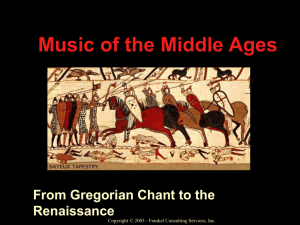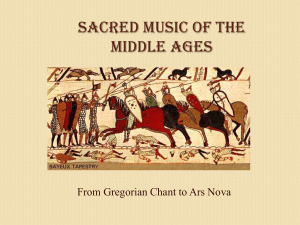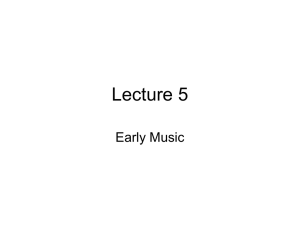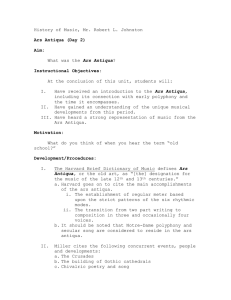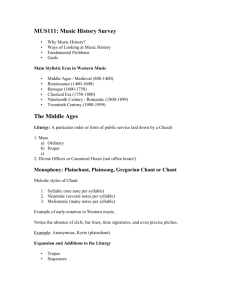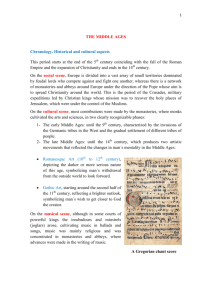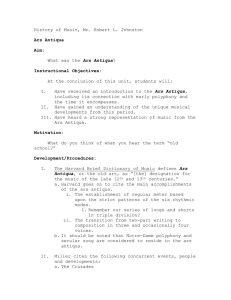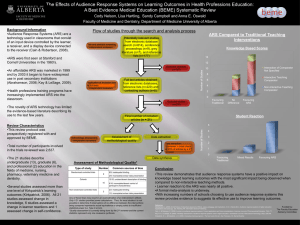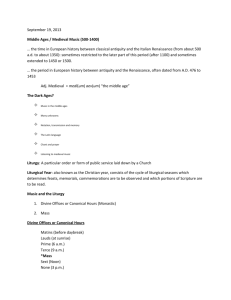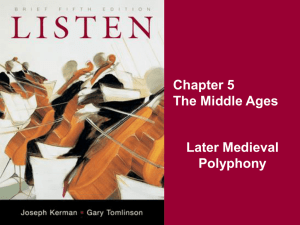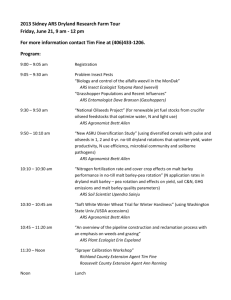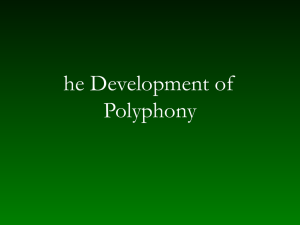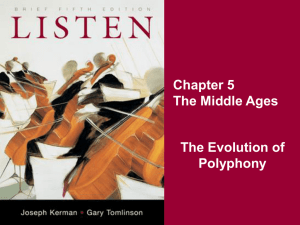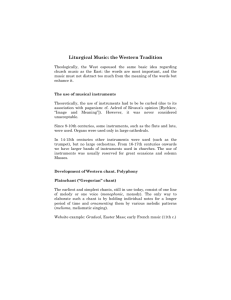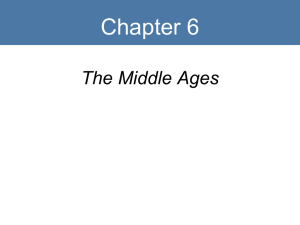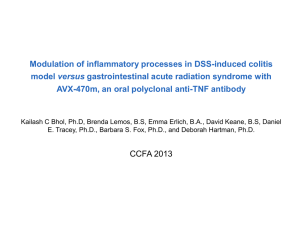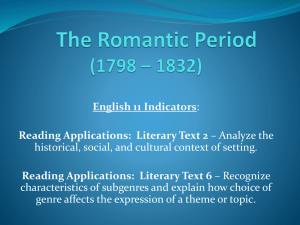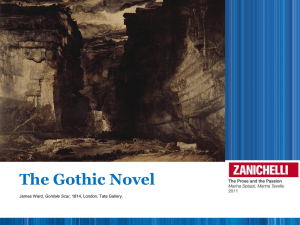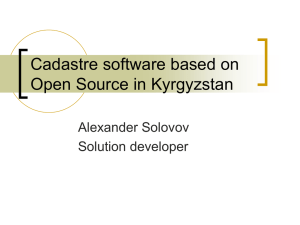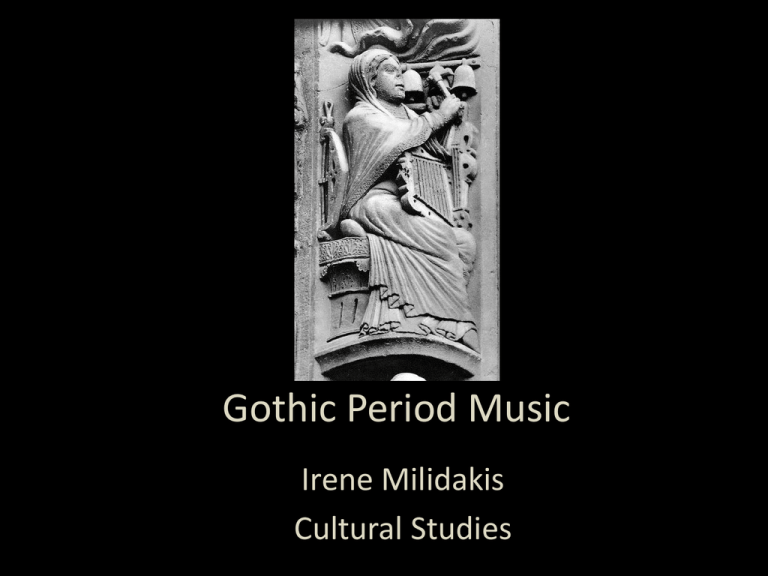
Gothic Period Music
Irene Milidakis
Cultural Studies
Building onto Traditions
• Gothic Period Music derived
from its preceding Romanesque
practices
• Gregorian Chant: simple,
monophonic liturgical music
•
•
•
•
Also known as plainchant
Sang in unison- monophonic
One melody- no harmony
Soloist and chorus singing in unison
would respond to each other
• Unaccompanied by instruments Musical notation was introduced by
acapella
Guido d’ArezzoGregorian Chant-Alleluia: Angelus
Depicted notes on a staff of lines
Domini
Organum- The Beginnings of Polyphony
• Chants became more complex
in the early 12th century
• The beginning signs of a
transition to the Gothic period
• Harmony “Organum” –
• Added an upper melody on top
of a cantus firmus (“fixed song”)
• Two different pitches sung by
two singers- “organa duplum”
• Simple harmonies
Early Organum - example of
Oblique Organum
Complex Progression
• Ars Antiqua (1175-1315)
•
•
•
•
•
Beginnings of polyphony
Simple organums
Triple Meter (3/4)
Mostly used two voices
Rapid transitions in music
notation and theory
• Beginning use of rhythmic
modes
• Ars Nova (1315-1430)
• Cantus Firmus used less and
less
• More complex rhythms
• Duple Meter (2/4)
• Use of many voices- “Motet”
• More secular than sacred
• Use of French and Latin
vernacular
• Rota- round
School of Notre Dame
Paris, France
• Notre Dame Cathedral
considered epicenter of
music organization in the
Ars Antiqua period
• The most well known
composers came from this
school
• Complex musical notation
was created
• First collections of music
producedMagnus Liber Organi by
Leonin c.1163
Great Masters of Notre Dame
• Leonin (ca.1163-1190)
• Great master of Ars Antiqua
period
• Help established polyphony
• Use of improvisation- not
known to have written own
music
• Use of organum duplumcantus firmus found in lower
voice while descanting voice
moves freely
Leonin- Organum Duplum
• Perotin (ca. 13th century)
• Great Master of Ars
Antiqua
• Helped established
polyphony
• Stricter melodic control
and clearer rhythms
• Added a third voice- three
part motet
• Still had a cantus firmus
Pérotin-Alleluia nativitas
Ars Nova: Breaking from Tradition
• Innovations• greater independence of
rhythm and polyphony
lines
• Tempus imperfectumduple meter
• Cantus firmus no longer
used
• Notable Composers• Guillaume de Machaut
-Subtle and strict melodic and
rhythmic compositions
Kyrie, from "Messe de Nostre
Dame“
• Philippe de Vitry
-Complex and fluid melodic and
rhythmic compositions
-Developed way of writing
rhythm on musical staffs
Tuba sacre fidei
Discussion Question
• What may have contributed to the growing interest
in innovating music?
Discussion Question
• What may have contributed to the growing interest
in innovating music?
- Increase in intellectual thought- formation of the university
brought intellectuals who contributed to the growing
musical developments
- Composers were open to daring innovation- as evident in
Leonin’s interest in improvisation
- Economical growth- The church was growing stronger
(along with the cities) which brought in funds, offerings to
assist in developing the arts
- All other facets of the arts were expanding themselves– the
architecture --
Reaching the Heavens
• Connected to the architecture• Sense of verticality heard in
music similar to architectureThey both reached towards
heaven
• Subjects of these new hymns
were often dedicated to Virgin
Mary as were most Cathedrals
• Growing complexity of music
mirrored the growing textual
complexity of the cathedrals’
architecture
Breaking Away from the Church
• Gothic period music was primarily created
for liturgy purposes but there was a
secularization that was occurring
throughout the 13th century.
• Courtly society brought about a need for
secular entertainment- minstrels
• These minstrels would sing and dance
often accompanied by instrumentals- folk
and popular music
• Troubadors appear in Germany in the 12th
c. and call themselves minnesingers –
“singers of love”- secular lyrical poetry
• Troubadors would often be employed by
the court as minstrels
• Tant m'abelis
Discussion Question
• What similarities are heard in the troubadour song
that are similar to the polyphonic music of the Ars
Nova period?
Discussion Question
• What similarities are heard in the troubadour song
that are similar to the polyphonic music of the Ars
Nova period?
- Rhythmic and melodic complexity
- Singers exhibiting vocal ability- vocal range, constant
change in pitch and tone
Contributions
• Gothic period music greatly
contributed to the developments in
musical study• All music today (both religious and
secular) would still sound like the
Gregorian Chant if polyphony was not
developed.
• Written collections of music made it
possible to access and continue the
musical tradition of this period and its
succeeding periods.
• Secularization would contribute to the
massive expansion of music creationwe often forget where contemporary
music derives from- not from the
church but from the individual
Discussion Question
• How is our culture still aware of these music traditions
today?
Discussion Question
• How is our culture still aware of these music
traditions today?
• Many European traditions would be brought over
including its religion
• Gothic period music was still largely a part of the
religious tradition so it was one of the many art
forms that were utilized by churches all over the
world
• Classical music was derived from church music continuation of polyphony in instrumental form
References
• Cunningham, Lawrence, and John J. Reich. Culture & Values: a
Survey of the Humanities / Lawrence S. Cunningham, John J.
Reich. Boston, MA: Wadsworth, 2010. Print.
• http://www.classicalscore.com/gothicera.htm
• http://musiced.about.com/od/faqs/f/plainchant.htm

